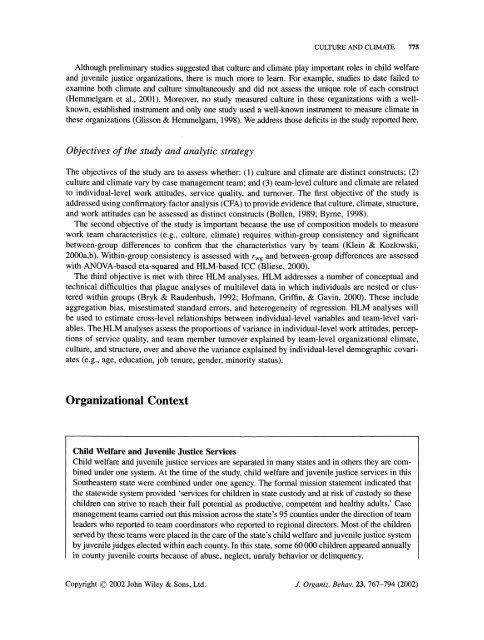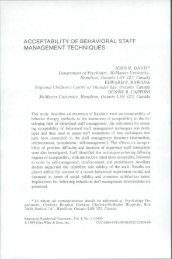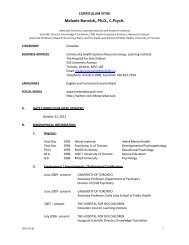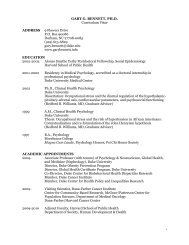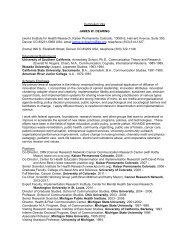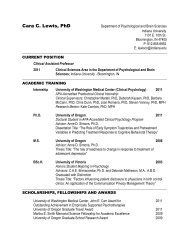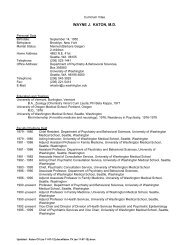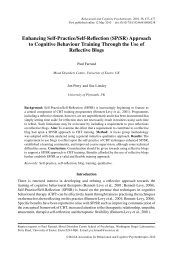The Cross-Level Effects of Culture and Climate in Human Service ...
The Cross-Level Effects of Culture and Climate in Human Service ...
The Cross-Level Effects of Culture and Climate in Human Service ...
Create successful ePaper yourself
Turn your PDF publications into a flip-book with our unique Google optimized e-Paper software.
CULTURE AND CLIMATE 775<br />
Although prelim<strong>in</strong>ary studies suggested that culture <strong>and</strong> climate play important roles <strong>in</strong> child welfare<br />
<strong>and</strong> juvenile justice organizations, there is much more to learn. For example, studies to date failed to<br />
exam<strong>in</strong>e both climate <strong>and</strong> culture simultaneously <strong>and</strong> did not assess the unique role <strong>of</strong> each construct<br />
(Hemmelgarn et al., 2001). Moreover, no study measured culture <strong>in</strong> these organizations with a wellknown,<br />
established <strong>in</strong>strument <strong>and</strong> only one study used a well-known <strong>in</strong>strumento measure climate <strong>in</strong><br />
these organizations (Glisson& Hemmelgarn, 1998). We address those deficits <strong>in</strong> the study reported here.<br />
Objectives <strong>of</strong> the study <strong>and</strong> analytic strategy<br />
<strong>The</strong> objectives <strong>of</strong> the study are to assess whether: (1) culture <strong>and</strong> climate are dist<strong>in</strong>ct constructs; (2)<br />
culture <strong>and</strong> climate vary by case management team; <strong>and</strong> (3) team-level culture <strong>and</strong> climate are related<br />
to <strong>in</strong>dividual-level work attitudes, service quality, <strong>and</strong> turnover. <strong>The</strong> first objective <strong>of</strong> the study is<br />
addressed us<strong>in</strong>g confirmatory factor analysis (CFA) to provide evidence that culture, climate, structure,<br />
<strong>and</strong> work attitudes can be assessed as dist<strong>in</strong>ct constructs (Bollen, 1989; Byrne, 1998).<br />
<strong>The</strong> second objective <strong>of</strong> the study is important because the use <strong>of</strong> composition models to measure<br />
work team characteristics (e.g., culture, climate) requires with<strong>in</strong>-group consistency <strong>and</strong> significant<br />
between-group differences to confirm that the characteristics vary by team (Kle<strong>in</strong> & Kozlowski,<br />
2000a,b). With<strong>in</strong>-group consistency is assessed with rwg <strong>and</strong> between-group differences are assessed<br />
with ANOVA-based eta-squared <strong>and</strong> HLM-based ICC (Bliese, 2000).<br />
<strong>The</strong> third objective is met with three HLM analyses. HLM addresses a number <strong>of</strong> conceptual <strong>and</strong><br />
technical difficulties that plague analyses <strong>of</strong> multilevel data <strong>in</strong> which <strong>in</strong>dividuals are nested or clustered<br />
with<strong>in</strong> groups (Bryk & Raudenbush, 1992; H<strong>of</strong>mann, Griff<strong>in</strong>, & Gav<strong>in</strong>, 2000). <strong>The</strong>se <strong>in</strong>clude<br />
aggregation bias, misestimated st<strong>and</strong>ard errors, <strong>and</strong> heterogeneity <strong>of</strong> regression. HLM analyses will<br />
be used to estimate cross-level relationships between <strong>in</strong>dividual-level variables <strong>and</strong> team-level variables.<br />
<strong>The</strong> HLM analyses assess the proportions <strong>of</strong> variance <strong>in</strong> <strong>in</strong>dividual-level work attitudes, perceptions<br />
<strong>of</strong> service quality, <strong>and</strong> team member turnover expla<strong>in</strong>ed by team-level organizational climate,<br />
culture, <strong>and</strong> structure, over <strong>and</strong> above the variance expla<strong>in</strong>ed by <strong>in</strong>dividual-level demographic covariates<br />
(e.g., age, education, job tenure, gender, m<strong>in</strong>ority status).<br />
Organizational Context<br />
Child Welfare <strong>and</strong> Juvenile Justice <strong>Service</strong>s<br />
Child welfare <strong>and</strong> juvenile justice services are separated <strong>in</strong> many states <strong>and</strong> <strong>in</strong> others they are comb<strong>in</strong>ed<br />
under one system. At the time <strong>of</strong> the study, child welfare <strong>and</strong> juvenile justice services <strong>in</strong> this<br />
Southeastern state were comb<strong>in</strong>ed under one agency. <strong>The</strong> formal mission statement <strong>in</strong>dicated that<br />
the statewide system provided 'services for children <strong>in</strong> state custody <strong>and</strong> at risk <strong>of</strong> custody so these<br />
children can strive to reach their full potential as productive, competent <strong>and</strong> healthy adults.' Case<br />
managementeams carried out this mission across the state's 95 counties under the direction <strong>of</strong> team<br />
leaders who reported to team coord<strong>in</strong>ators who reported to regional directors. Most <strong>of</strong> the children<br />
served by these teams were placed <strong>in</strong> the care <strong>of</strong> the state's child welfare <strong>and</strong> juvenile justice system<br />
by juvenile judges elected with<strong>in</strong> each county. In this state, some 60 000 children appeared annually<br />
<strong>in</strong> county juvenile courts because <strong>of</strong> abuse, neglect, unruly behavior or del<strong>in</strong>quency.<br />
Copyright ? 2002 John Wiley & Sons, Ltd. J. Organiz. Behav. 23, 767-794 (2002)


